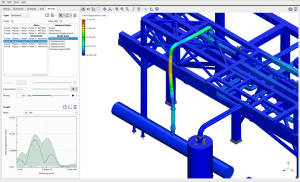
Performing Vibration Measurements: Pipe Stress Assessment
Training Courses Performing Vibration Measurements: Pipe Stress Assessment Free Course Preview Download Brochure About The Course This course teaches you all the fundamentals required for
Are you engaged in technical matters concerning buried industrial piping? This course imparts essential knowledge of soil mechanics and its influence on underground piping. Upon completion, you will have a comprehensive understanding of the technical aspects related to buried piping. This course caters not only to piping engineers but also offers valuable insights for operators, supervisors, technicians, and plant managers.
Key topics covered encompass relevant design codes (e.g., NEN 3650, ATV, AWWA), solutions to common stress issues, underground pipe support, thrust blocks, awareness of critical aspects, potential failure mechanisms, identification of field and design issues, and distinctions between buried steel and non-steel piping.
The course comprises 7 online modules featuring video content and provides one year of unrestricted access to both the course materials and the discussion forum, enabling you to revisit modules as necessary to reinforce your knowledge for professional projects.
Please note that this course requires an active Caesar II license, which is not provided as part of the course. For inquiries regarding licensing, please don’t hesitate to contact us.
Welcome to the course
Your instructors
How to use this course
Personal Certificate requirements
Introduction to Buried Piping
Soil Pipe Interaction
Failure Mechanisms in underground piping
Typical Design Solutions
Installation
Modeling and Design Codes
Introduction to Soil Mechanics
Soil Classification Methods
Stresses on Soil Elements
Stress-strain Relations for Soil Elements
Equilibrium of Stresses in Soil Layers
Introduction to Soil Mechanics
Lateral Soil Resistance
Vertical Soil Resistance
Axial Soil Resistance
Soil Pipe Stiffness
Soil Implementation in Stress Models
Longitudinal Stresses
Exercise 2a Introduction
Summary of Module 2
Exercise 2a Discussion
Finite Element Analysis
Caesar II Pipe Stress
Caesar II Soil Modeler pt1
Caesar II Soil Modeler pt2
Underground Element Sizes
Additional Axial Restraints
Soil Settlements
Best Practices
Exercise 2b Introduction
Exercise 2b Discussion
Introduction to Buckling
Upheaval Pipe Buckling
Ring Type Buckling
Soil Settlements
Buried Pipe Installation Layouts
Exercise 3 Introduction
Exercise 3 Discussion
Buried Piping codes: A summary
NEN3650-1, -2, and -3: Scope of the codes
Soil-Pipe Resistance pt 1 according to NEN3650-1
Soil-Pipe Resistance pt 2 according to NEN3650-1
Settlements and uncertainty according to NEN3650-1
Traffic load according to NEN3650-1
NEN3650-2 & NEN3650-3
AWWA M11 Code
Exercise 5 Introduction
Exercise 5 Discussion
Underground Supporting & Structures
Stress Relief Methods
Soil Improvement
Comparison Between Some Soil Models
Exercise 7 Introduction
Remaining Topics
Calculating Buoyancy Failure pt1
Calculating Buoyancy Failure pt2
Questions to Bend Radii
Questions to Branches
Questions to Concrete Encasement
Support model for CAESAR II
Pipe sleeves
Congratulations
Course evaluation survey
Your Personal Certificate
Rate this course
Related resources & follow up
Self-Paced
This course is self-paced and is not subject to specific dates. The course contains 7 modules with a total of 6.5 hours of content which can be performed at your own pace. A personal certificate will be provided to you if you finish the course within the first month after purchase. This incentive aims to motivate you to perform the course on time, thereby improving your learning curve.
Classroom
This course is scheduled over 1 work day.
This course is available in self-paced, hybrid, and classroom formats.
Prerequisites and level
Intended For:
This course is designed for:
Access to the course
After your purchase is confirmed it will be activated to your account on the EngineeringTrainer learning portal. Here you will find the course in your dashboard and you will be guided step-by-step through the different course modules. You receive 1-year unlimited access to the course. This allows you to perform modules again when you need to refresh your knowledge for your work projects.
Learn by doing
The course is mainly based on video content: video lectures and video software demonstrations. English subtitles are available and videos can be viewed as many times as desired. The video lectures help you to grasp the important technical concepts and in the video demonstrations the instructor uses the software and discusses all the steps and actions. You are recommended to follow the steps of the instructor in the software to optimize your learning curve.
Exercises are available in the form of multiple-choice quizzes to help you grasp technical concepts and in the form of PDF files with instructions to build and analyze different models and answer related questions. Video demonstrations of the exercises are available.
Participants of the self-paced and E-hybrid courses receive a personal digital certificate if they meet the following requirements:
Participants of the classroom course receive a personal physical certificate upon the completion of the course.
Example certificate:

After this course, participants are expected to:
Video lectures,
Video demonstrations,
Exercise .pdfs & video tutorials,
Discussions forum with other participants & instructor.
The majority of training material are videos. These are not available for download, but can be accessed directly with your account on the portal. The exercise files can be downloaded. These can include .pdf files with the exercise questions, software models or other related types.
You receive 1-year unlimited access to the course. This allows you to watch content again if this is beneficial for your work projects..
We encourage participants to submit feedback and questions in the Discussions Forum of the course. These are either answered directly in the forum or form the basis for new videos that are added to the online course on a regular basis.
Participants receive 1-year unlimited access to the course including new videos that are added during this year. Participants receive an email notification upon addition of new course videos.
An active CaesarII license is required for this course. This is not included in the course. Please contact us for questions on this matter.
If your computer and internet connection is able to play videos online (YouTube) you will be able to follow the course. Note that almost all browsers are supported, except for Internet Explorer.
Yes, this course qualifies for PDH hours as per the NCEES CPC Guidelines.

Training Courses Performing Vibration Measurements: Pipe Stress Assessment Free Course Preview Download Brochure About The Course This course teaches you all the fundamentals required for

Training Courses Piping: Structural Integrity About The Course Enhance your expertise in addressing technical challenges on a petrochemical plant. Join our introductory level ‘Piping Structural

Training Courses Pipe Stress Analysis Free Course Preview About The Course Pipe stress engineering is a broad area of expertise. To perform a pipe stress
Laan van Oversteen 20
6th floor
2289 CX Rijswijk
The Netherlands
© Dynaflow Research Group BV